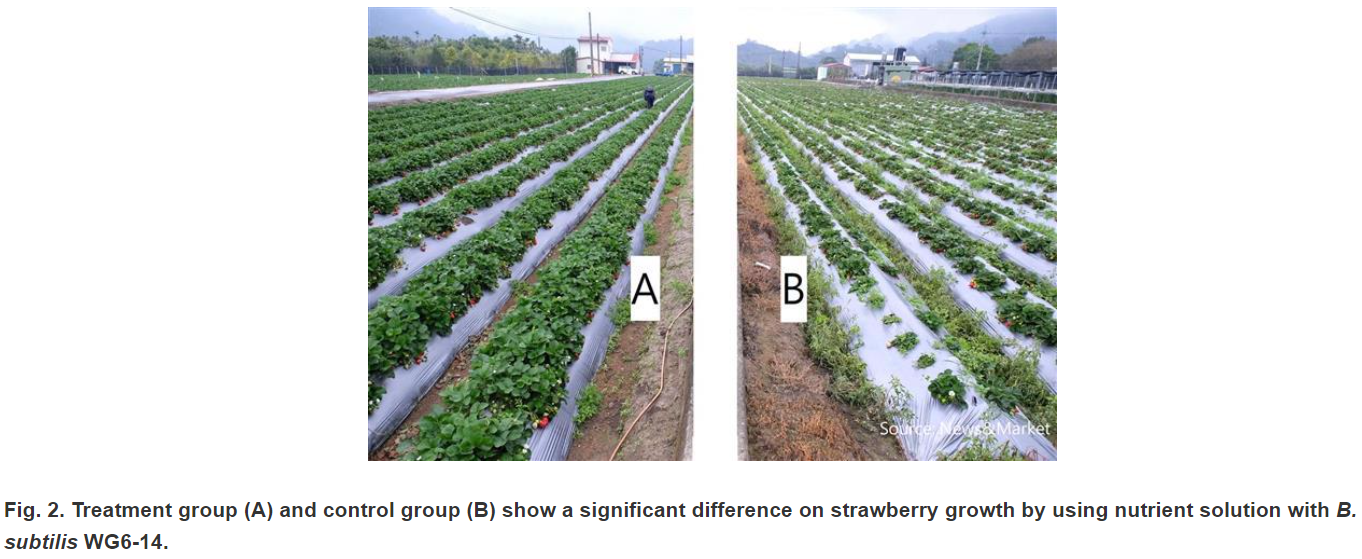The total strawberry production area in Taiwan is about 550 hectares, with an average yield of 13, 619 kg per hectare. In 2016, around 7,487 tons of strawberries were produced, valued at nearly TWD 1.8 billion (USD 59.3 million). (Agricultural Statistical Yearbook, Executive Yuan Agriculture and Food Agency, Council of Agriculture, Executive Yuan, R.O.C., 2017). Average strawberry seedling demand is about 27.5 million. The suitable nursery environment for strawberry seedlings requires high humidity and under shade condition, plus high planting density, which is also optimum for anthracnose disease development. Anthracnose is an important disease of strawberry that can affect seedling, foliage, runners, crowns and fruit in both nursery and field. The fungus can survive on infected plants and plant debris, which make farmers struggle to control this disease. Anthracnose disease has led to strawberry seedling shortage up to 4 million in 2016, which causes a severe impact on strawberry industry in Taiwan.
However, the resistance/susceptibility of strawberry to strawberry anthracnose vary by cultivars. The strawberry varieties cultivated in Taiwan are mainly ‘Feng Hsiang’ (豐香) and ‘Hsiang Shui’ (香水). With strawberry anthracnose infection on seedlings can cause 30-40% ‘Feng Hsiang’ plant death in field. Replanting increases the production cost, while the condition favors strawberry anthracnose disease development, even results in 90% replanting, causing severe crop loss.
In 2019, Taiwan Agriculture Research Institute, COA has developed strawberry IPM for controlling strawberry anthracnose. Before planting, organic fertilizers (containing molasses, soybean meal, rice bran, etc.) were mixed into soil and covered with plastic mulch for two weeks for killing pathogenic fungi in soil. After land preparation and tillage, strawberry seedlings were treated with Bacillus amyloliquefaciens P-2-2 (106 cfu/ml) and planted into the field, which would reduce the replanting rate of strawberry. The results indicate that the replanting rate of treatment group and control was 37.6% and 10.7% in ‘Feng Hsiang’, respectively; likewise, the replanting rate of treatment and control was 15.4% and 1.5% in ‘Hsiang Shui’. This strawberry IPM would save farmers approximately TWD 260,000 (8,600 USD) production cost per hectare.
 Furthermore, National Chung Hsing University has developed a nutrient solution with Bacillus subtilis WG6-14. Farmer Wu, who is in Miaoli has sprayed the leaves once every 3-4 days and also irrigated the soil once every 7-10 days with this solution after planting until harvest. In February 2020 field trail, the strawberry plants applied this nutrient solution are healthy and strong than untreated ones. The proportion of larger fruits were as high as 70%, and the average yield was increased by 25%. Also, the use of chemical pesticides and fertilizers was reduced by 50%.
Furthermore, National Chung Hsing University has developed a nutrient solution with Bacillus subtilis WG6-14. Farmer Wu, who is in Miaoli has sprayed the leaves once every 3-4 days and also irrigated the soil once every 7-10 days with this solution after planting until harvest. In February 2020 field trail, the strawberry plants applied this nutrient solution are healthy and strong than untreated ones. The proportion of larger fruits were as high as 70%, and the average yield was increased by 25%. Also, the use of chemical pesticides and fertilizers was reduced by 50%.

Advances cultural techniques for effectively reducing strawberry crop loss
The total strawberry production area in Taiwan is about 550 hectares, with an average yield of 13, 619 kg per hectare. In 2016, around 7,487 tons of strawberries were produced, valued at nearly TWD 1.8 billion (USD 59.3 million). (Agricultural Statistical Yearbook, Executive Yuan Agriculture and Food Agency, Council of Agriculture, Executive Yuan, R.O.C., 2017). Average strawberry seedling demand is about 27.5 million. The suitable nursery environment for strawberry seedlings requires high humidity and under shade condition, plus high planting density, which is also optimum for anthracnose disease development. Anthracnose is an important disease of strawberry that can affect seedling, foliage, runners, crowns and fruit in both nursery and field. The fungus can survive on infected plants and plant debris, which make farmers struggle to control this disease. Anthracnose disease has led to strawberry seedling shortage up to 4 million in 2016, which causes a severe impact on strawberry industry in Taiwan.
However, the resistance/susceptibility of strawberry to strawberry anthracnose vary by cultivars. The strawberry varieties cultivated in Taiwan are mainly ‘Feng Hsiang’ (豐香) and ‘Hsiang Shui’ (香水). With strawberry anthracnose infection on seedlings can cause 30-40% ‘Feng Hsiang’ plant death in field. Replanting increases the production cost, while the condition favors strawberry anthracnose disease development, even results in 90% replanting, causing severe crop loss.
In 2019, Taiwan Agriculture Research Institute, COA has developed strawberry IPM for controlling strawberry anthracnose. Before planting, organic fertilizers (containing molasses, soybean meal, rice bran, etc.) were mixed into soil and covered with plastic mulch for two weeks for killing pathogenic fungi in soil. After land preparation and tillage, strawberry seedlings were treated with Bacillus amyloliquefaciens P-2-2 (106 cfu/ml) and planted into the field, which would reduce the replanting rate of strawberry. The results indicate that the replanting rate of treatment group and control was 37.6% and 10.7% in ‘Feng Hsiang’, respectively; likewise, the replanting rate of treatment and control was 15.4% and 1.5% in ‘Hsiang Shui’. This strawberry IPM would save farmers approximately TWD 260,000 (8,600 USD) production cost per hectare.